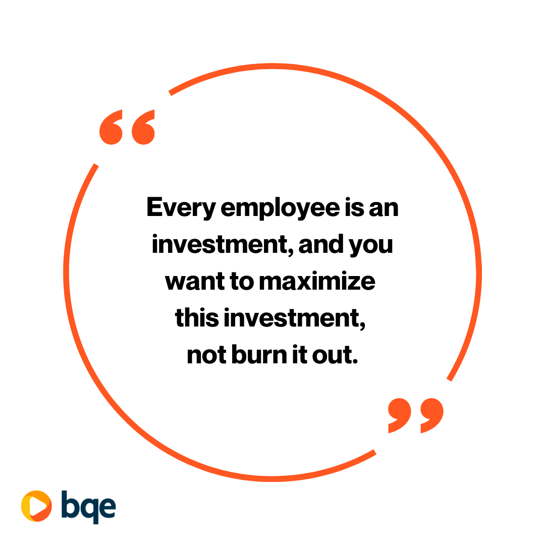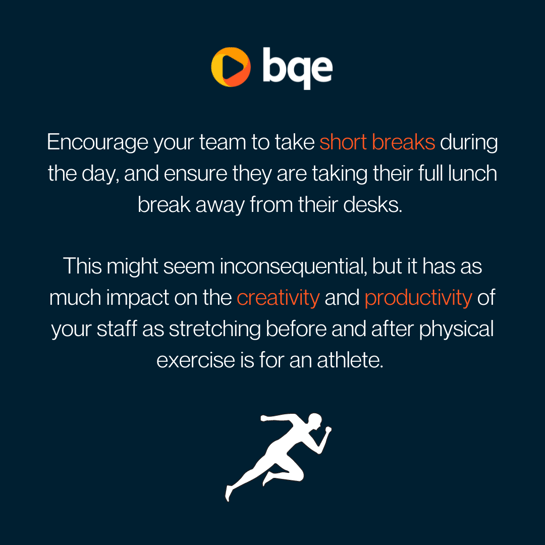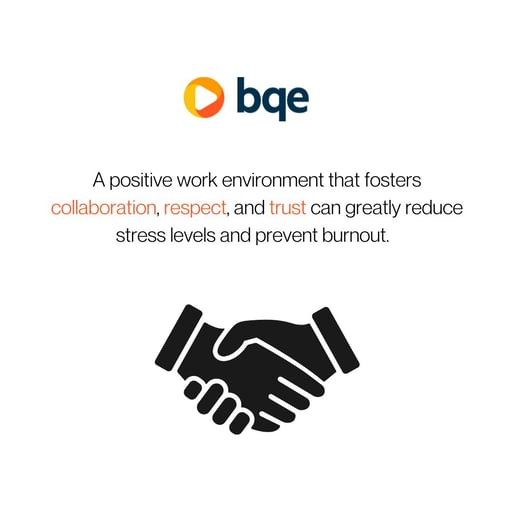An Expert’s Advice: Why You Need Time Tracking Software for Architects
Steven Burns, FAIA, details how time tracking software can help your firm improve profitability and get employees to fill out time on time every...
Every employee is an investment, and you want to maximize this investment, not burn it out. Here are 10 tips to prevent employee burnout.
Let’s talk employee burnout. We’ve all been there: it’s 1:30 am and you're sitting at your desk, staring at the computer screen trying to wrap things up before the big meeting. And, it’s a Saturday!
During my early days as an architect at a large firm in Chicago, I might have unofficially set a record for the longest stretch of sleepless work - a staggering 75 hours. This marathon task was necessitated by a project deadline set for a Friday. I didn't take any breaks or naps, laboring continuously for what amounted to three whole nights.
In my sleep-deprived state, I fancied that I had stumbled upon a hidden truth: staying awake for three successive days would eliminate the need for sleep altogether. The exhaustion took a toll on my senses, making my brain feel as though it was cushioned inside a one-inch-thick foam helmet - a peculiar sensation indeed.
In retrospect, I was clearly delusional. I can't help but think that the decisions I was making during this time were far from ideal. The episode finally came to an end on the third day when a colleague found me still at my desk in the morning. Realizing my state, they took the initiative to pry me from my workstation, drive me home, and ensure that I got the sleep I so desperately needed.
As architects, we are primed to do all-nighters starting with our first year of architectural school. It’s part of the cult and a badge of honor to do this. In addition, we love to design so much, that this doesn’t even feel wrong. For some of us, it’s an addiction. And if you’re in any other professional services industry, you no doubt have a similar situation when it comes to feeling like you have put in the extra work- or you’re not working.
As a sole practitioner, this isn’t nearly as horrible as it is when you become an employer and your staff continues this tradition. By now, we all understand how critically important sleep is for our overall health and optimal functioning. As a business owner, you must recognize that employee burnout is a serious issue that can impact not only the productivity and quality of your team’s work, but also their overall health and well-being.

Most firms I know list their team as their most valuable asset. If this is indeed the case, you need to treat them that way. If you’re heartless and think there is nothing wrong with working your staff to exhaustion, (that’s what your boss did to you when you were young), that this is just part of the culture; I would like to appeal to your business sense. Every employee is an investment, and you want to maximize this investment, not burn it out.
The productivity consultant, David Allen is famous for having said
“Overwork is the surest way to underachievement.”
As an employer, it’s crucial to address this issue proactively. The solution begins with you. It begins by becoming a better manager and creating a strong, caring culture in your firm.
I’m going to give you 10 tips to prevent employee burnout that your firm should practice. Some of you might say, you are already doing some of these. Great. However, you must be doing ALL of these in order to ensure your firm and your employees remain healthy, engaged, appropriately challenged, trusting, and loyal.
Encourage a culture that values quality over quantity. Make sure workloads are distributed evenly and that deadlines are realistic. Regularly review workloads and check in with your team to ensure they are not overloaded.
Use technology, such as BQE CORE to help manage project budgets and schedules.
Balancing transparency with empathetic leadership is crucial in managing workloads effectively. Implement a consistent feedback mechanism to understand individual capacities and potential bottlenecks in work processes.
This two-way communication allows employees to voice their concerns or issues, fostering a supportive environment.
Strive to prioritize tasks based on their urgency and significance, encouraging employees to focus their energy where it matters most.
I mentioned BQE CORE because I’ve personally used this in my work and can confirm that it helps manage heavy workloads thus preventing employee burnout. By leveraging the comprehensive functionalities of BQE CORE, you can efficiently manage task assignments, visualize workloads, and set realistic expectations. This balanced approach goes a long way in reducing stress levels and minimizing the risk of employee burnout.
Regular breaks help employees relax and recharge. Encourage your team to take short breaks during the day, and ensure they are taking their full lunch break away from their desks. This might seem inconsequential, but it has as much impact on the creativity and productivity of your staff as stretching before and after physical exercise is for an athlete.
Periodic longer breaks (e.g., vacations) are also essential. Insist your employees take their earned vacation time.

If you sense employee burnout, do what my boss once did to me. Go over to that person’s desk, tap them on the shoulder, and say, “Hey, why not grab a book, head out to the park, and read for the rest of the afternoon? Go enjoy yourself.”
This isn’t a waste of time. This is refueling the brain. Sparking creativity. Work done when an employee is exhausted and frustrated will more than likely need to be redone when they have a clear, rested mind.
We all believe in this, but few of us actually practice this.
Avoid encouraging long working hours and working over the weekend regularly. Encourage your employees to have a healthy work-life balance by having time for their personal lives and interests outside of work.
Establishing a healthy work-life balance doesn't just happen, it requires proactive efforts from both the management and the individual employees. Companies can play a significant role by implementing flexible working hours, encouraging time-off, (I’ll touch more on these later) and endorsing digital-detox periods.
Remember, the goal is not just to prevent employee burnout, but to create an environment where employees feel valued and motivated. When employees feel supported in maintaining their work-life balance, they are more likely to stay engaged, productive, and committed to their roles, thus reducing turnover and increasing overall company performance.
A few other ideas you can try include:
Set Boundaries: Encourage employees to set clear boundaries between their work and personal life. This might involve not checking emails outside of work hours or setting designated 'quiet hours' where work discussions are discouraged.
Time Management Training: Provide training on effective time management techniques to help employees work more efficiently and make the most of their time.
Encourage Hobbies and Interests: Promote a culture where having interests outside of work is valued. This could mean sharing personal achievements in non-work related areas or providing space for hobby clubs within the company.
Encourage employees to voice their concerns, challenges, or ideas.
Having regular check-ins or one-on-ones can help identify issues early on and make employees feel heard and supported. Regular check-ins with employees about their workload and stress levels not only allows them to feel heard, but you can have a firm of transparency which helps with your employee retention as well. After these check ins, make adjustments as needed to ensure no one is feeling overwhelmed.
Don’t wait for an annual performance review to speak deeply with your employees.
This can include providing access to professional counseling services, promoting mental health awareness, or even offering mindfulness and relaxation activities, such as yoga or meditation sessions.
I’m a recent convert to meditation. I wish I had learned this 40 years ago!
Here are a few more mental health support strategies you should consider implementing:
Promote Open Dialogue: Cultivate a workplace culture where mental health topics can be openly discussed without stigma. Regular communication about mental health, through workshops or awareness programs, can help create an environment of understanding and empathy.
Provide Employee Assistance Programs (EAPs): EAPs are workplace resources that offer confidential assessments, counseling, and referrals for employees dealing with personal or work-related issues, including mental health concerns. They are usually available to employees free of charge.
Mindfulness and Stress Management Training: Mindfulness exercises and stress management techniques can also be extremely beneficial. Offering training in these areas, or providing resources such as apps or online courses, can empower employees to take control of their mental health.
Access to Mental Health Professionals: Provide access to mental health professionals, such as counselors or psychologists, either in-person or through teletherapy services. Regular mental health screenings can also help in early detection of any issues.
Promote Physical Wellness: Physical health significantly impacts mental health. Encouraging physical activity, providing healthy food options, and promoting regular breaks can contribute to better mental well-being.
Offer Mental Health Days: Consider providing mental health days as part of your leave policy, giving employees time to focus on self-care without using vacation or sick days.
Recognize and reward your employees' hard work. This can be as simple as verbal recognition, an employee of the month program, or small bonuses or gifts.
Don’t take these efforts for granted.
Picture this: You're putting your heart and soul into your work, and one fine day, your boss strolls over with a big grin, pats you on the back, and says, "Hey, great job on that project. You really knocked it out of the park!" Now, doesn't that feel like a fresh, crisp hundred-dollar bill on a sunny day? That's what recognition does. It tells our hardworking comrades, "We see you. We appreciate you. Your work matters."
When employees feel valued, they're not just happier, they're also more productive.
Offering opportunities for career advancement can help employees feel that they are growing and that their work is meaningful, which can in turn reduce feelings of burnout.
No one wants to go into a career and know the role they’re in is it. No advancements, no areas to learn more and grow. They’ve hit that ceiling. This can cause employee burnout quickly.
Invest in your employees. Give them the opportunity to grow and you’ll have happy hardworking employees that you proudly watch take on new roles that help them and your firm continue to expand and succeed.
A positive work environment that fosters collaboration, respect, and trust can greatly reduce stress levels and prevent burnout.

This can be achieved through team-building activities, clear and positive communication, and a safe and comfortable physical workspace.
Another reason why firm culture is one of the first things every owner should consider when building a practice. Your firm’s culture is becoming just as important as the paycheck. People want to make money, but they don’t want to make money in a place where they hate the culture.
Flexible work environments have been found to not only help with preventing employee burnout and creating a better work-life balance, but it can also help your employees get more work done. When you cut out the daily commute and then unwind from the commute and the office small talk and the “now I have to stop work and hit the road before terrible traffic” there’s more time in the day for employees to just stress less and focus more.
This style of work has become more common since COVID-19.
If possible, offering flexible work arrangements such as remote work, flexible hours, or compressed work weeks can help employees better balance their personal and professional lives.
Make sure your employees have the necessary tools and resources to perform their jobs effectively.
This includes up-to-date software, efficient equipment, and proper training.
Look into business, office and project management software solutions that are built around the unique needs of the A/E and professional services industries. Evaluate which tools make the best sense for your firm.
Make sure you include BQE CORE in that analysis. It’s worth it. I’ll even direct you to a free demo.
In closing, as a leader, your actions and attitudes can significantly influence your team. Avoid overworking yourself, take breaks, communicate openly, and show appreciation for your team. This will set a positive example for your employees and help your entire firm prevent employee burnout and thrive like never before.
Steven Burns, FAIA, is a renowned global thought leader, architect, and highly sought-after speaker on topics related to emerging technologies and effective firm management. As the founder of The Well-Designed Firm, a cutting-edge business consultancy, Steven is committed to helping A/E firms elevate their business practices to the same level of elegance as the architecture they create. With a Master of Architecture degree from the prestigious Harvard Graduate School of Design and over 7 years of experience at SOM, Steven is a true expert in his field. He also founded his own architecture firm, BBA Architects, which he successfully sold in 2007. Steven's contributions to the architecture industry go beyond his work as an architect and business consultant. He is also the mastermind behind ArchiOffice, a popular project and office management software that he developed and later sold to BQE Software in 2010.
Steven Burns, FAIA, details how time tracking software can help your firm improve profitability and get employees to fill out time on time every...
If you make a project management investment, learn how to get the most out of it so employees adopt it and your business thrives.
Are you looking for a cost-effective way to drive revenue and client engagement? Here's why you should invest in business intelligence and analytics.
Be the first to know the latest insights from experts in your industry to help you master project management and deliver projects that yield delighted clients and predictable profits.